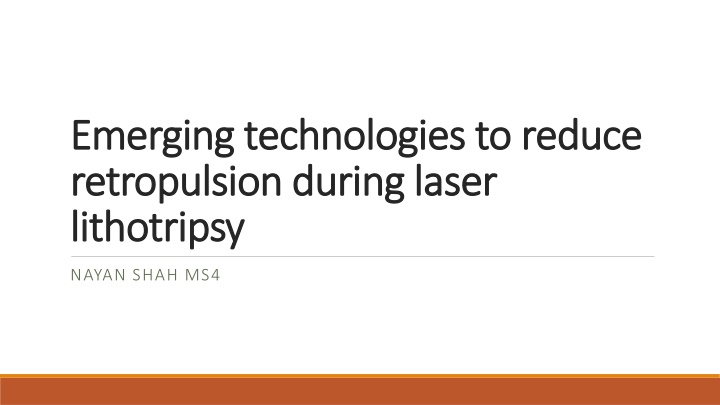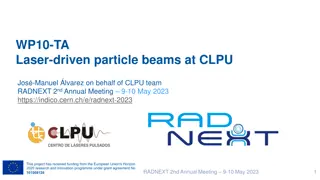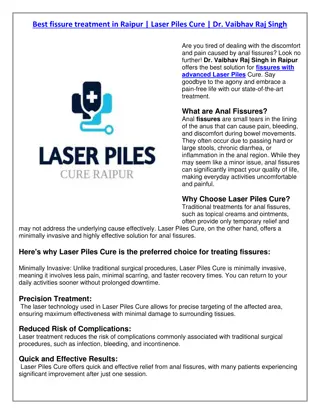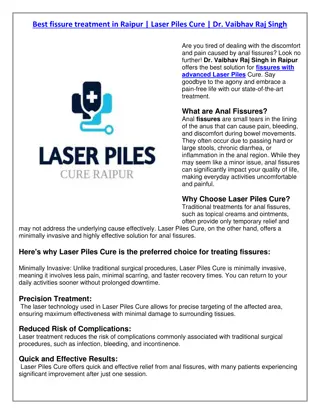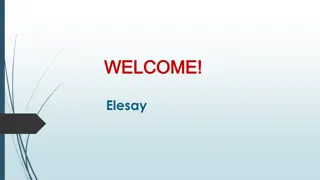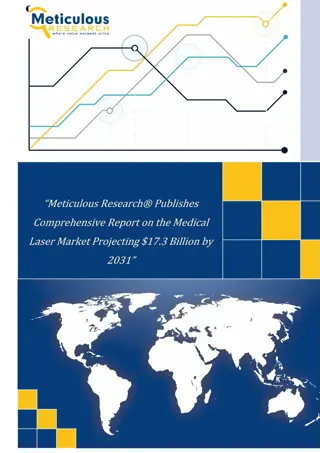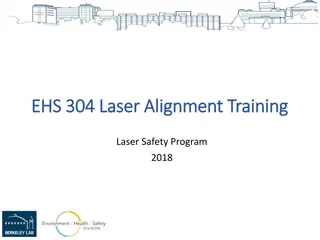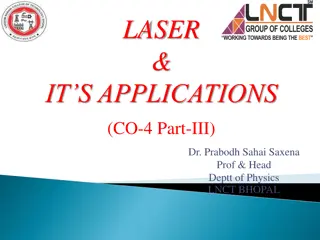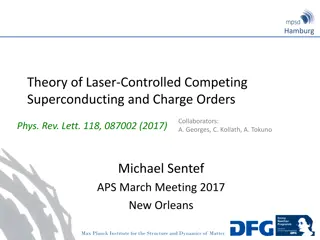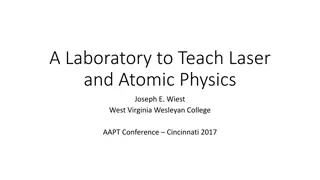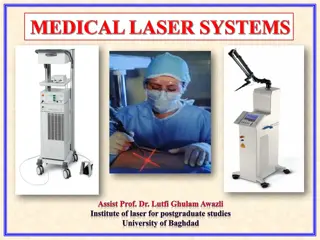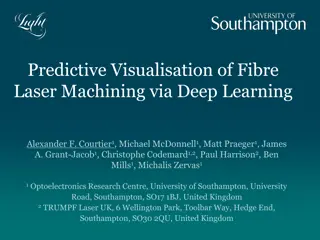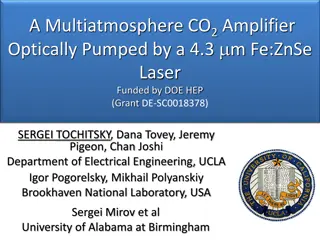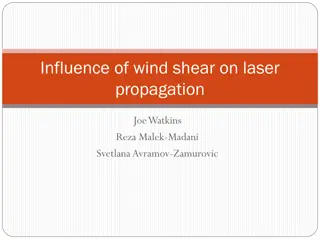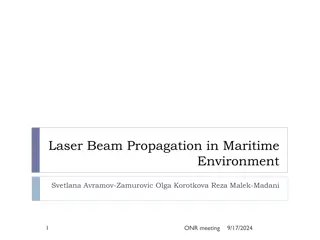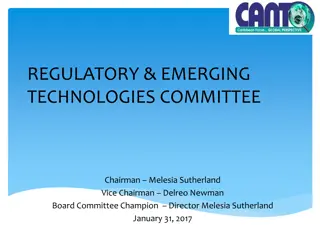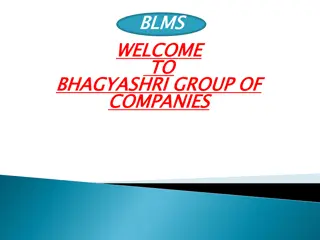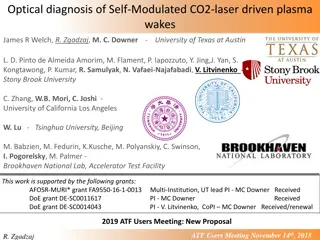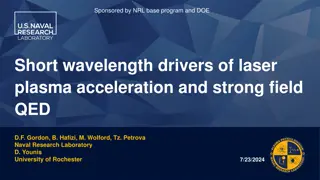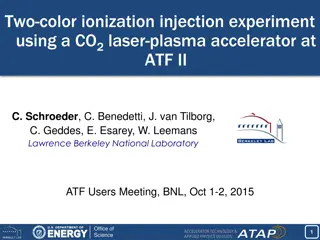Emerging Technologies to Reduce Retropulsion in Laser Lithotripsy
Background information on laser lithotripsy using Ho:YAG lasers, adjustable laser settings for fragmentation and dusting, and the use of long pulse settings in reducing retropulsion. In vitro comparisons of Holmium lasers show evidence for shorter fragmentation time and decreased retropulsion using modern variable-pulse lasers. An update on lasers in urology discusses current assessments on Ho:YAG laser lithotripter settings and laser fibers.
Download Presentation

Please find below an Image/Link to download the presentation.
The content on the website is provided AS IS for your information and personal use only. It may not be sold, licensed, or shared on other websites without obtaining consent from the author.If you encounter any issues during the download, it is possible that the publisher has removed the file from their server.
You are allowed to download the files provided on this website for personal or commercial use, subject to the condition that they are used lawfully. All files are the property of their respective owners.
The content on the website is provided AS IS for your information and personal use only. It may not be sold, licensed, or shared on other websites without obtaining consent from the author.
E N D
Presentation Transcript
Emerging technologies to reduce Emerging technologies to reduce retropulsion during laser retropulsion during laser lithotripsy lithotripsy NAYAN SHAH MS4
Background information Long pulse settings Moses mode Thulium fiber lasers
Background information Background information Laser lithotripsy is commonly used during ureteroscopy to treat kidney stone disease Currently Ho:YAG is the gold standard for laser lithotripsy First used in early 1990s Solid state laser that delivers energy via thin/flexible fiber Especially useful in flexible ureteroscopy Suitable for fragmentation of all stone types Favorable safety profile Some disadvantages of Ho:YAG Retropulsion Movement away from laser fiber upon energy delivery Restrictions on fiber size and frequency settings
Adjustable laser settings Fragmentation: High energy, low frequency Dusting: Low energy, high frequency Aldoukhi, A. et al. Urol Clin North Am. 2019.
In Vitro Comparison of Holmium Lasers: Evidence for Shorter Fragmentation Time and Decreased Retropulsion Using a Modern Variable- pulse Laser Bell, J. R.; Penniston K. L.; Nakada, S.Y. Urology. 2017. Compared variable pulse width laser (300 us, 700 us) with fixed pulse laser (350 us) Pvc ureter model with synthetic stone (BegoStone) Mimicked calcium oxalate monohydrate Single urologist fragmented each stone completely
In Vitro Comparison of Holmium Lasers: Evidence for Shorter Fragmentation Time and Decreased Retropulsion Using a Modern Variable- pulse Laser Bell, J. R.; Penniston K. L.; Nakada, S.Y. Urology. 2017.
Update on lasers in urology 2014: current assessment on holmium:yttrium aluminum garnet (Ho:YAG) laser lithotripter settings and laser fibers Kronenberg, Peter; Traxer, Olivier. World Journal of Urology. 2015. Study using automated system showed less ablation with long pulse settings
The Moses effect The Moses effect - physical phenomena that occurs with laser use in a fluid environment Ho:YAG laser emits light at wavelength of 2120 nm, readily absorbed by water (1910 nm absorption peak) Energy absorbed by water leads to microbubble formation Once bubble reaches target, beam can pass through with little attenuation Microbubble can be triggered with very little energy
Moses Technology An optimization of the Moses effect Modulates Ho:YAG output Low energy initiation pulse Time delay High energy pulse Developed by Lumenis First commercially available in 2017 2 settings Contact (Moses A): used at 1 mm Distance (Moses B): used at 2 mm Has been shown to drastically decrease retropulsion Aldoukhi, A. et al. Urol Clin North Am. 2019.
Moses Technology in a Stone Simulator Ibrahim, A.; Badaan, S.; Elhilali, M.; Andonian, S. Canadian Urological Association Journal. 2018. Compared Moses contact mode to conventional settings in simulator that mimics human urinary system Assessed fragmentation and dusting capabilities using artificial 5 mm stone and Moses 200 um core fiber Fragmentation 0.8 J/10 Hz Dusting: 0.4 J/50 Hz Degree of stone retropulsion subjectively assessed Grade 0 no retropulsion Grade 1 displacement with return to original location Grade 2 displacement of 1-2 cm Grade 3 migration to elsewhere in the kidney
Moses Technology in a Stone Simulator Ibrahim, A.; Badaan, S.; Elhilali, M.; Andonian, S. Canadian Urological Association Journal. 2018.
Moses Technology in a Stone Simulator Ibrahim, A.; Badaan, S.; Elhilali, M.; Andonian, S. Canadian Urological Association Journal. 2018. Significant difference in overall procedure duration Fragmentation 13.9 vs. 9.1 min; p=0.01 Dusting 9.3 vs 7.1 min; p<0.01 No significant differences in total lasing time or total energy required
Moses Technology in a Stone Simulator Ibrahim, A.; Badaan, S.; Elhilali, M.; Andonian, S. Canadian Urological Association Journal. 2018.
Initial Clinical Experience with a Modulated Holmium Laser Pulse-Moses Technology: Does It Enhance Laser Lithotripsy Efficacy? Mullerad, M.; Aguinaga, J. R. A.; Aro, T.; Kastin, A.; Goldin, O.; Kravtsov, A.; Assadi, A.; Badaan, S.; Amiel, G. E.. Rambam Maimonides Medical Journal. 2017. Little clinical data on Moses technology has been published One study showed that 5 urologists over 23 procedures described Moses mode as much better or better than regular laser lithotripsy in 18 of the procedures. Study reported faster fragmentation rate with Moses technology.
The Moses Holmium System Time is Money Stern, K. L.; Monga, M. Canadian Urological Association Journal. 2018. In order to use Moses technology hospitals must have a P120 capable Moses laser and a dedicated Moses fiber Study compared cost of Moses technology to Boston Scientific TracTip system Moses cost $39,900 more for laser/software Moses fiber $919 vs TracTip fiber $560.84 Assumed $100/minute cost of OR time Assumed procedure time decreased 35% with Moses technology Calculated average lasing time of 3.02 minutes using Boston scientific system 40 patient sample size Estimated that Moses system increased cost of each case by $292.36
Thulium fiber lasers Thulium fiber lasers (TFL) First studied in late 90s, output power < 5 W Now output power of >100 W Different from Thulium:YAG solid state laser Has been used for soft tissue ablation in urologic tissues
Ho:YAG laser generation Traxer O et al. Journal of Urology. 2019.
TFL laser generation Traxer O et al. Journal of Urology. 2019.
Energy Wavelength Water absorption peak 1910nm Ho:YAG emission 2120 nm TFL emission 1940 nm Traxer O et al. Journal of Urology. 2019.
Comparing Ho:YAG and TFL Parameter Wavelength Pulse energy range Pulse duration range Maximum pulse frequency Ho:YAG 2120 nm 0.2-6.0 J 0.04-1 ms 120 Hz TFL 1940 nm 0.025-6.0 J 0.05-12 ms 2000 Hz Lowest compatible fiber core diameter 200 um 50 um Resistance to external shocks low high Retropulsion ++ -- Ablation rate -- ++ Scott NJ et al. IEEE Journal of Selected Topics in Quantum Electronics. 2009
Comparing Short, Long, and Moses Regimes of Ho:YAG Laser vs Super Pulse Thulium Fiber Laser In Vitro: Ablation Speed and Retropulsion Effect Olivier Traxer; Vincent De Coninck; Etienne Xavier Keller; Steeve Doizi. Presented at 2019 AUA Annual Meeting Compared TFL to Ho:YAG short pulse, long pulse, and Moses modes Recorded retropulsion using 200 um core fibers and equal energy/frequency settings Looked at initial speed and cumulative displacement after one second of firing
Comparison of Dusting and Fragmentation Using the New Super Pulse Thulium Fiber Laser to a 120W Holmium:YAG Laser Ben Chew; Bodo Knudsen; Wilson Molina. Presented at 2019 AUA Annual Meeting Compared TFL to Ho:YAG laser using both fragmentation and dusting settings Measured time to reduce 5 mm3 stones to fragments <1mm Evaluated size of fragments after 2 kJ of energy were delivered using dusting settings
Comparison of Dusting and Fragmentation Using the New Super Pulse Thulium Fiber Laser to a 120W Holmium:YAG Laser Ben Chew; Bodo Knudsen; Wilson Molina. Presented at 2019 AUA Annual Meeting Measured time to reduce 5 mm3 stones to fragments <1mm
Comparison of Dusting and Fragmentation Using the New Super Pulse Thulium Fiber Laser to a 120W Holmium:YAG Laser Ben Chew; Bodo Knudsen; Wilson Molina. Presented at 2019 AUA Annual Meeting Evaluated size of fragments after 2 kJ of energy were delivered using dusting settings
Conclusions Long pulse settings, Moses mode, and TFLs have all been shown to produce less retropulsion when compared to traditional Ho:YAG lithotripsy in in vitro models. Moses mode has been shown to be more efficient than traditional Ho:YAG lithotripsy especially using dusting settings. Thulium fiber lasers may represent a more efficient technology for laser lithotripsy than Ho:YAG solid state lasers regardless of the settings used. Studies have shown that TFL technology allows for better ablation rates, less retropulsion and the use of smaller laser fibers than Ho:YAG. Currently there is very little clinical data on the use of these new technologies. More studies are needed to evaluate the potential clinical impact of these differences.
References 1. Aldoukhi AH, Black KM, Ghani KR. Emerging Laser Techniques for the Management of Stones. Urol Clin North Am. 2019;46(2):193-205. 2. Roger BJ, L. PK, Y. NS. In Vitro Comparison of Stone Fragmentation When Using Various Settings with Modern Variable Pulse Holmium Lasers. Journal of Endourology.2017;31(10):1067-1072. 3. Bell JR, Penniston KL, Nakada SY. In Vitro Comparison of Holmium Lasers: Evidence for Shorter Fragmentation Time and Decreased Retropulsion Using a Modern Variable- pulse Laser. Urology. 2017;107:37-42. 4. Chew BH, Knudsen BE, Molina WR. MP79-19 HOLMIUM:YAG LASER. Journal of Urology. 2019;201(Supplement 4):e1159-e1160. COMPARISON OF DUSTING AND FRAGMENTING USING THE NEW SUPER PULSE THULIUM FIBER LASER TO A 120W 5. Ibrahim A, Badaan S, Elhilali MM, Andonian S. Moses technology in a stone simulator.Can Urol Assoc J. 2018;12(4):127-130. 6. Kronenberg P, Traxer O. In vitro fragmentation efficiency of holmium: yttrium-aluminum-garnet (YAG) laser lithotripsy--a comprehensive study encompassing different frequencies, pulse energies, total power levels and laser fibre diameters.BJU Int. 2014;114(2):261-267. 7. Kronenberg P, Traxer O. Update on lasers in urology 2014: current assessment on holmium:yttrium aluminum garnet (Ho:YAG) laser lithotripter settings and laser fibers. World Journal of Urology. 2015;33(4):463-469. 8. Mullerad M, Aguinaga JRA, Aro T, et al. Initial Clinical Experience with a Modulated Holmium Laser Pulse-Moses Technology: Does It Enhance Laser Lithotripsy Efficacy? Rambam Maimonides Med J. 2017;8(4). 9. Stern KL, Monga M. The Moses holmium system - time is money.Can J Urol. 2018;25(3):9313-9316. 10. Traxer O, Coninck VD, Keller EX, Doizi S. MP17-03 ABLATION SPEED AND RETROPULSION EFFECT. Journal of Urology.2019;201(Supplement 4):e255-e256. COMPARING SHORT, LONG, AND MOSES REGIMES OF HO:YAG LASER VS SUPER PULSE TM FIBER LASER IN VITRO: 11. Traxer O, Keller EX. Thulium fiber laser: the new player for kidney stone treatment? A comparison with Holmium:YAG laser. World J Urol. 2019.
